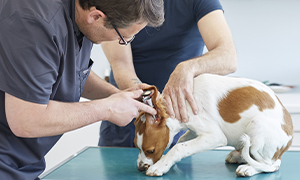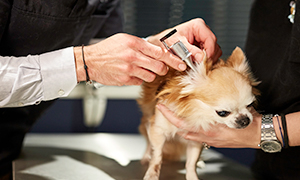How Important Is an Ear Cleaner in the Short and Long-Term Management of Otitis Externa in Dogs?

A topical antibiotic, antifungal and anti-inflammatory preparation is commonly prescribed. Cleaning the ear appropriately, however, has proven to be very important in the overall management and will vastly affect the success rate.
The choice of manual cleaning with a cleaner versus retrograde flush under general anaesthesia will be dependent on multiple factors: severity of the symptoms, temperament of the dog, etc.
Were manual cleaning to be chosen, an adequate choice of product and its properties is crucial. Alongside its physical action, the ceruminolytic agents (such as salicylic acid or lactic acid) and surfactant effect will contribute to breaking and evacuating the debris, and therefore helping the action of the antibiotic.
The antimicrobial action of an ear cleaner is also to be considered, as it will help the action of the antibiotic drop in the short term and can reduce the overall need of antibiotic in the longer term. Agents such as EDTA, parachlorometaxylenol (PCMX) and isopropyl alcohol are widely used and have proven benefits against bacteria like Pseudomonas aeruginosa. Some monosaccharides such as D-galactose, D-mannose or L-rhamnose prevent the bacterial adhesion (Pseudomonas, Staphylococcus), significantly reducing the bacterial population. Some products also either contain or stimulate the production of antimicrobial peptides (AMP’s), which are small, cationic polypeptides that are part of the innate immune system and have clear benefits in the reduction of the antibiotic load required.
Once clinical control of the acute episode is achieved, an ear cleaner will play a large part in the long term control and prevention of relapses, especially for patients with underlying conditions such as canine atopy or when the ear is damaged and the epithelial migration is poor. The need to demonstrate to clients how to use the ear cleaner cannot be stressed enough. Veterinary nurses can play a great role in that, helping to build a strong relationship with the client as well as helping the patient. The ear canal should be filled with product and the vertical canal gently massaged for 30 to 60 seconds. The material can then be wiped away gently. This should be repeated regularly at a frequency depending on the case, weekly cleaning being the average recommendation once the ear canal is clean.
In summary, choosing the right ear cleaner according to its properties is vital in the successful management of otitis externa, alongside client education to ensure good compliance.
1. Carlotti D.N, Trenti D, Germain P.A. Otite externe et nettoyage auriculaire. Pratique Vet Anim Comp 2005 ; 20:7-10
2. Forsythe P.J. Acute otitis externa: the successful first-opinion ear consultation. In Practice 2016; 38:2-6
3. Nuttall T. Successful management of otitis externa. In Practice 2016; 38:17-21



